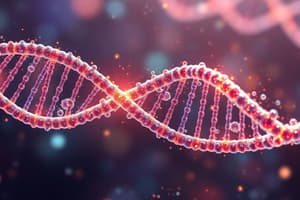Podcast
Questions and Answers
What is the primary function of bacterial alkaline phosphatase (BAP) in gene manipulation?
What is the primary function of bacterial alkaline phosphatase (BAP) in gene manipulation?
BAP hydrolyzes 3’ and 5’ phosphate from nucleic acid (DNA/RNA), removing phosphate groups before end labeling and from vectors prior to insert ligation.
Why is calf intestinal alkaline phosphatase (CIP) used in gene cloning experiments?
Why is calf intestinal alkaline phosphatase (CIP) used in gene cloning experiments?
CIP is used to remove phosphate groups from the 5’ end of DNA and RNA, preventing self-ligation and recircularization of vectors.
What is the effect of inorganic phosphates on bacterial alkaline phosphatase (BAP) activity?
What is the effect of inorganic phosphates on bacterial alkaline phosphatase (BAP) activity?
Inorganic phosphates reduce BAP activity.
What is the characteristic that makes shrimp alkaline phosphatase (SAP) suitable for use in cloning?
What is the characteristic that makes shrimp alkaline phosphatase (SAP) suitable for use in cloning?
At what temperature does bacterial alkaline phosphatase (BAP) show optimal activity?
At what temperature does bacterial alkaline phosphatase (BAP) show optimal activity?
What is the purpose of dephosphorylation in cloning experiments?
What is the purpose of dephosphorylation in cloning experiments?
What type of enzyme is alkaline phosphatase?
What type of enzyme is alkaline phosphatase?
What is the source of calf intestinal alkaline phosphatase (CIP)?
What is the source of calf intestinal alkaline phosphatase (CIP)?
Why is it necessary to remove phosphate groups from vectors prior to insert ligation?
Why is it necessary to remove phosphate groups from vectors prior to insert ligation?
What is the characteristic that makes bacterial alkaline phosphatase (BAP) suitable for use in gene manipulation?
What is the characteristic that makes bacterial alkaline phosphatase (BAP) suitable for use in gene manipulation?
Flashcards are hidden until you start studying




